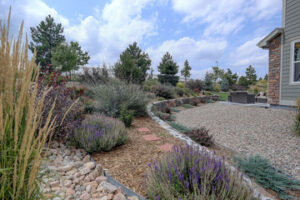Home » Landscaping
Category Archives: Landscaping
The Benefits of a Xeriscaping Garden
Many people envision a dry and barren landscape when hearing the word xeriscape, but Xeriscape Colorado Springs don’t have to be austere. Many plants have physical adaptations to conserve water, like prickly spines and thick skin that reduce water loss through evaporation.
Plants native to your area or that thrive in a similar climate are great xeriscape choices. Proper soil enhancement, a layer of mulch, and drip irrigation systems that deliver water deep into the ground can also make a big difference.
As climate changes, many regions are experiencing more and longer periods of drought. Water restrictions have become more common, and gardeners are looking for ways to save time, money, and water in the landscape. Xeriscaping is one way many people choose to go green and reduce their environmental footprint. The key to a xeriscape is to use plants that are naturally adapted to your area’s soil, sun and rainfall. These are the plants that will thrive, grow quickly and produce beautiful flowers despite low moisture conditions.
Cacti are perhaps the most well-known xeriscape plant, but they are not the only ones that can be used. There are many shrubs, flowers and trees that are able to handle arid conditions. For example, agave is a popular choice for xeriscape gardens because it can be grown in full sun and requires very little water. Juniper is another drought-tolerant shrub that can be grown in many climates. It can be used for hedging or to create privacy screens. Other shrubs that are good choices for xeriscape gardens include prickly pear, pomegranate and oleander. A variety of perennial flowers can also be used in a xeriscape garden, including lavender (Lavandula spp), petunia, roses and daisies. These flowers are often long-blooming and make great additions to any flower garden.
Even some vegetables can be used in a xeriscape, such as black walnuts and Jerusalem artichokes. Many herbs are also drought tolerant, including thyme and rosemary. Some varieties of grass are also able to survive in dry conditions, such as buffalograss and blue grama. Adding mulch to the garden is important for a xeriscape, because it helps reduce evaporation and promotes deeper root systems.
While xeriscaping is most commonly used in arid regions, there are benefits that can be enjoyed by any gardener. Plants that are native to your region tend to be more drought tolerant than exotic landscape plants, but there are also plenty of exotic options available. By planting a mix of native and exotic plants, you can have a lush garden that uses less water.
Easy To Maintain
Xeriscaping can save you time and money by reducing watering needs and eliminating the need for fertilizer and pesticides. It’s also a great way to be environmentally friendly. By using less water, you can reduce the strain on local reservoirs, wastewater treatment plants and aquifers. Additionally, xeriscape can help reduce the amount of energy used to power lawn mowers and grow and transport water-intensive plants.
While many people associate xeriscaping with cactus and desert-like plants, it can be lush and green in almost any climate. Choosing native plants that are well-suited to your area and soil type is crucial to your success. Plants that are adapted to your climate will be better equipped to handle varying amounts of sunlight and moisture, and will resist drought conditions and disease more effectively than other types of plants.
In addition to selecting the right plants, proper soil preparation is essential. Spreading a thick layer of organic material (like compost) over the landscape helps improve the soil’s structure, and locks in moisture. Incorporating a layer of mulch with wood chips, pebbles or gravel prevents weed growth and conserves water by slowing evaporation.
When it comes to watering, it’s important to use an efficient irrigation system that is tailored to your landscape and its plants. Watering in the morning is best, as the cooler temperatures minimize evaporation and allow plants to absorb more water efficiently. A professionally-designed xeriscape can help you create a water-efficient landscape that is beautiful and healthy.
Unlike traditional lawns, xeriscape can add color and interest to your yard through the use of ground cover, rock, or masonry. Plants like sedum, agave and succulents offer color and texture to your landscape, while shrubs and perennial flowers provide variety. You can even use flowers and shrubs from Mediterranean-type climates, such as rosemary or lavender, to add a European touch.
Using decorative hardscaping, such as pavers or slate, instead of traditional turf grass, provides an attractive and modern look that can last a lifetime. In addition, pavers and masonry can reduce the amount of foot traffic on your garden and landscape beds, extending the life of your plants and preventing erosion in high-traffic areas.
Water Savings
The most obvious benefit of xeriscaping is the significant water savings that can be realized. Since xeriscape plants are well-adapted to local weather conditions, they don’t need the extra watering that turf landscapes require. Xeriscapes also reduce the need for expensive irrigation equipment and services.
The xeriscape movement is gaining steam in response to rising utility costs and environmental concerns. Many cities offer rebates to encourage xeriscaping.
When done well, a xeriscape can be as beautiful as any traditional landscape. Many people assume xeriscapes look like a southwestern desert scene, but that’s not necessarily true. Native plants are often used in a xeriscape, but there are many other options, as well.
Creating a xeriscape starts with careful planning and assessment of the property’s strengths and weaknesses. The first step is to diagram the yard, taking into account how much sun it gets, which areas are used for family activities and social gatherings, and where utilities such as gas lines and electrical lines run through the property. It is also important to determine how much rainfall occurs in the area. This information will help you decide what zones to create. Typically, a xeriscape garden has three zones: an arid zone that features the most drought-tolerant plants; a transition zone, where moderately water use plants are mixed in with the arid plants; and a lush zone, which is closest to the house and usually includes the lawn area.
Once the landscaping has been planned, it’s important to install the proper water-saving infrastructure. This can include drip irrigation and low-flow sprinklers to prevent wasting water through evaporation. Using mulch, such as decomposed granite, can also be helpful, as it helps prevent weeds and soil erosion.
A xeriscape plan is an ideal way to save water while maintaining the beauty of your yard. But it’s not a foolproof solution to high water bills. You’ll still need to make regular checks to ensure that weeds are kept at bay and that the plants are being properly maintained.
Aesthetics
Many homeowners who have adopted the xeriscape approach find that they enjoy the appearance of their new gardens as much as, or even more than, traditional landscapes. This is because a well-designed xeriscape garden includes a diverse array of colorful plants that add interest throughout the year, so you never have to be bored with your yard.
Using a xeriscape garden means that you are using only the amount of water that nature provides, allowing for significant savings in both water and wastewater charges for your home. This is especially important if you live in an area that experiences frequent drought-like conditions. Xeriscaping can also help to protect the environment by reducing the amount of water that is runoff into rivers and lakes.
In a xeriscape landscape, plants are chosen that are suited to the local climate and general conditions. This closely, if not exactly, resembles dryland gardening which uses only those plants that are naturally adapted to the arid environment.
One of the key elements of a xeriscape garden is the use of mulch. Mulch preserves the soil’s water retention, slows evaporation and helps to control weeds. It is available in both organic and inorganic forms, including wood chips, shredded bark, leaves and grass clippings. Inorganic mulches are typically decorative or rock-based and can be used to create attractive landscape features such as borders and paths.
There are also several types of xeriscape plants that offer unique benefits when it comes to enhancing your landscaping with color and fragrance. These include succulents, cacti and bromeliads, which store water in their thick, waxy leaves or flowers. Aloes and agaves have reduced transpiration because they have needle-like leaves that reduce surface area, while arid plants such as rosemary and oregano have small flowers that do not require a lot of water to produce.
Studies linking landscape aesthetics to ecological values and human perception are beginning to be incorporated into the field of environmental aesthetics. However, the decoupling between aesthetics and ecological functioning is expected to be more challenging than for other environmental values such as habitat quality or biodiversity.

